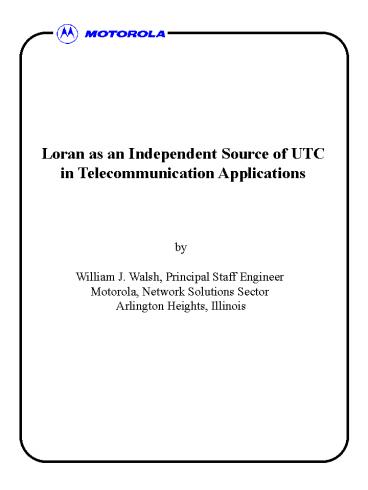CDMA BTS SYNCHRONIZATION - PowerPoint PPT Presentation
1 / 14
Title:
CDMA BTS SYNCHRONIZATION
Description:
Loran as an Independent Source of UTC. in Telecommunication ... Detour, MI - August 17, 2002. Bay City, MI - August 17, 2002. Zanesville, OH - August 17, 2002 ... – PowerPoint PPT presentation
Number of Views:283
Avg rating:3.0/5.0
Title: CDMA BTS SYNCHRONIZATION
1
Loran as an Independent Source of UTC in
Telecommunication Applications
by William J. Walsh, Principal Staff Engineer
Motorola, Network Solutions Sector Arlington
Heights, Illinois
2
Telecommunications Synchronization Overview
Central Ofc.
Local Ofc.
End Ofc.
End Ofc.
Public Switching Network
End Ofc.
T1
MSC
T1
BTS
Motorola SC4812 CDMA Modem Frame (BTS)
CBSC
T1
T1
Air Interface
Air Interface
BTS
BTS
Air Interface
Air Interface
3
GPS Alone Cannot Provide Necessary Reliability
- Real Life Problems Encountered by Motorola
- Unintentional Jamming
- - Television Stations
- - Spurious Emissions by Paging Transmitters
- - Unknown Sources
- - Known Sources (e.g. Phoenix and Rome, NY)
- Intentional Jamming
- - US government tests
- Poor Satellite Reception
- - Urban Canyons
- - Ice / Snow Buildup on Antennas
- GPS Satellite Failures
- - September 1995 (SVN10)
- - March 18, 1997 (SVN35)
4
Benefits of Loran in Telecommunications as Backup
Synchronization Source to GPS
- Independent System - no common mode failures,
such as - unintentional jamming.
- Only other source of UTC - UTC is necessary for
base station - start-up, when GPS might not be available.
- Infinite backup capabilities - can function as
primary - clock (like GPS), vs short term limitation of
Rb - Performance - penetration into urban
environments - Reliability - very reliable technology with low
support - costs (vs Rb)
- Proven technology with established user base
- Low cost
5
IS-95 CDMA Specification and UTC Requirement
Note CDMA requirement was specifically
developed to enable use of Rb as backup to GPS,
which was to be the primary reference. However,
Rb can only meet this specification for a short
period of time and cannot generate UTC.
6
Block Diagram of Mobile Experimental System
Note system clock operates at 19.6608 MHz, so
resolution of these measurements is 51 nSeconds,
which is more than adequate given the CDMA
synchronization specification.
7
Test Procedure 1. GPS was powered on and allowed
to stabilize. 2. Loran was powered on and
allowed to stabilize. No ASF corrections were
used by the receiver. 3. A command was issued to
the Loran receiver to calculate TAI. After
the receiver completed the calculation, it
moved the 1PPS phase to the TAI. 4. The offset
between GPS UTC and Loran TAI was determined
by the number of system clock ticks between
the 1 PPS outputs of each receiver, which was
then multiplied by the system clock cycle. 5.
Mobile tests typically took 30 minutes. 6.
Static tests were conducted periodically on
September 16 17, 2002 in Wilmington, NC.
8
Mobile Test Setup
GPS Antenna
LFR Antenna
CSM
LFR
Loran antenna was 18 e-field.
9
Test Sites and Loran Transmitters
10
Mobile Test Results
11
Static Test Results in Wilmington, North Carolina
September 16_12_19gmt
September 16_14_53gmt
September 16_21_21gmt
Note Wilmington, NC site is 11nm from Carolina
Beach transmitter, so 18 e-field antenna lowered
to attentuate signal.
12
September 17, 2002 Static Test Results in
Wilmington, North Carolina
13
Summary and Conclusions
- Tests on Lorans ability to provide an
independent source - of UTC were conducted at 12 sites in 5 states
using - different master stations for phase locking.
- The specified CDMA synchronization requirement
is lt10 uS drift per day, with 3 uS drift
desirable. - Lorans UTC accuracy is virtually entirely
dependent on - ASF, and is a function of distance to the
station. - In all trials where the master was located less
than 1000 - miles from the test site, Loran provided UTC
accuracy - about an order of magnitude better than the
required - CDMA specification, even without using ASF
corrections.
14
Summary and Conclusions
- In all test sites, at least two additional Loran
masters were - nearer than 1000 miles, therefore at least two
more - redundant sources of UTC are likely to be
available. - Loran easily met system requirements in both
near- - overload (e.g. 11 nm from transmitter) and
far-fringe (e.g. - 1100 miles distant from transmitter)
conditions. - When USCG upgrades tighten Loran timing
controls, - then
- - Loran UTC performance will improve
- - Use of secondaries is facilitated by TOE
- With use of ASF corrections and a well
controlled - infrastructure, Loran UTC performance could be
2 - orders of magnitude better than the CDMA
requirement - - and synchronization requirements are
expected to - increase in the future.































